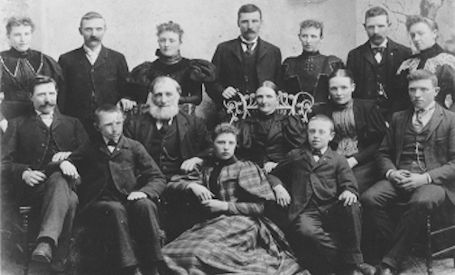
A farm for a pair of boots? My version!
May 1, 2023
In May of 1847, surveyor Alex Wilkinson was directed by the Commissioner of Crown Lands in Upper Canada to make a survey “along the shore of Lake Huron, northerly from Ashfield,” in order to open up the Queen’s Bush for settlement. This survey was completed by the following summer and settlers were soon choosing lots on which to establish themselves.
By 1850, a goodly number of them obtained a Licence to Settle on Concession A and began clearing the land and building a shanty and log barn. These lands were designated as School Lands and became available for purchase July 31, 1852. The price was 10 shillings per acre, payable in 10 yearly installments. Clearing was to begin immediately, with five acres cleared each year for five years.

“Families and Farms of Huron” tells us that the John Emmerton family, along with the Henry Robinsons and Chris Barkers, arrived in Upper Canada from England in the summer of 1849 and claimed Lots 41-44. The township papers list John as occupying Lots 42 and 43 in 1850.
In 1853, he transferred the rights to Lot 42 to Edward Thornhill who transferred it in 1855 to John Pollock. The history book tells it this way: “Being a bridge builder and framer by trade, John (Emmerton) was not expressly eager to clear and farm land so traded Lots 41 and 42 to (John) Pollock, a cobbler, for several pair of boots.”
Now there is no mention in our family history of the Pollocks having skills as cobblers but consider John Thompson. In December, 1853, he received a Licence for Lots 36 and 37 on Concession 7. Lot 37 would have met the corner of Lot 41, Concession A, if not for the road allowance intervening. He had come from Ireland as did the Pollocks, and the Thompson story describes him as a shoemaker.
In my imagination, John Pollock read the notices about the opening-up of the Queen’s Bush and came to the area looking for available land. Huntingdon and Rawdon Townships in Hastings County, where his older brother, William, was settled, had been well established by 1850. I think he likely found work with families needing help to meet their obligations, perhaps with the Thompsons whose daughter, Jane, he married a few years later. Thus, he would have access to a supply of sturdy boots.
But how does Edward Thornhill come into the picture? John Pollock paid him 107 pounds and 10 shillings for Lot 42, May 8, 1855. Edward and his wife, Martha, perhaps a Barker (an older son was Edward Barker Thornhill), had four children between May, 1853, and June, 1860. They were all baptized at the Anglican Church of the Messiah where records indicate that Edward was a resident of Kincardine village and a bailiff.
Two Barker families obtained Licences for Lots 45 and 46 by 1854. Perhaps, Edward was convinced there was a benefit in owning land nearby. However, by 1855, the lot was sold. Had he been unable to fulfill the requirements? Did he or his wife not wish to leave an easier existence in the village? Or had he not paid John Emmerton?
I can imagine that John Pollock’s Irish wit and some fine boots made by his future father-in-law, convinced Mr. Emmerton that a deal would be advantageous! Now, that’s my story!

These are the seven sons and six daughters of John and Jane Thompson Pollock who grew to adulthood on Lots 41 and 42, Concession A; in the back, Sadie (left), Tom, Alice, John Jr., Elizabeth, Robert Andrew, Isabelle; and in the front, William (left), Charles Wesley, John Sr., Margaret, Jane Thompson, Alfred, Mary Jane, and James David
-- January, 2021
Ruth Anne Hollands Robinson
References:
- Families and Farms of Huron
- History of the County of Bruce, Norman Robertson, Vol. 1
- Records of the Anglican Church of the Messiah, Kincardine
More notes: Fannie C. Thornhill, age 23, daughter of Edward Thornhill and Martha Barker, was married in Kincardine in 1885.
Ruth Anne Hollands Robinson
Comment on this story? Click here.
Related Stories
No related stories.






